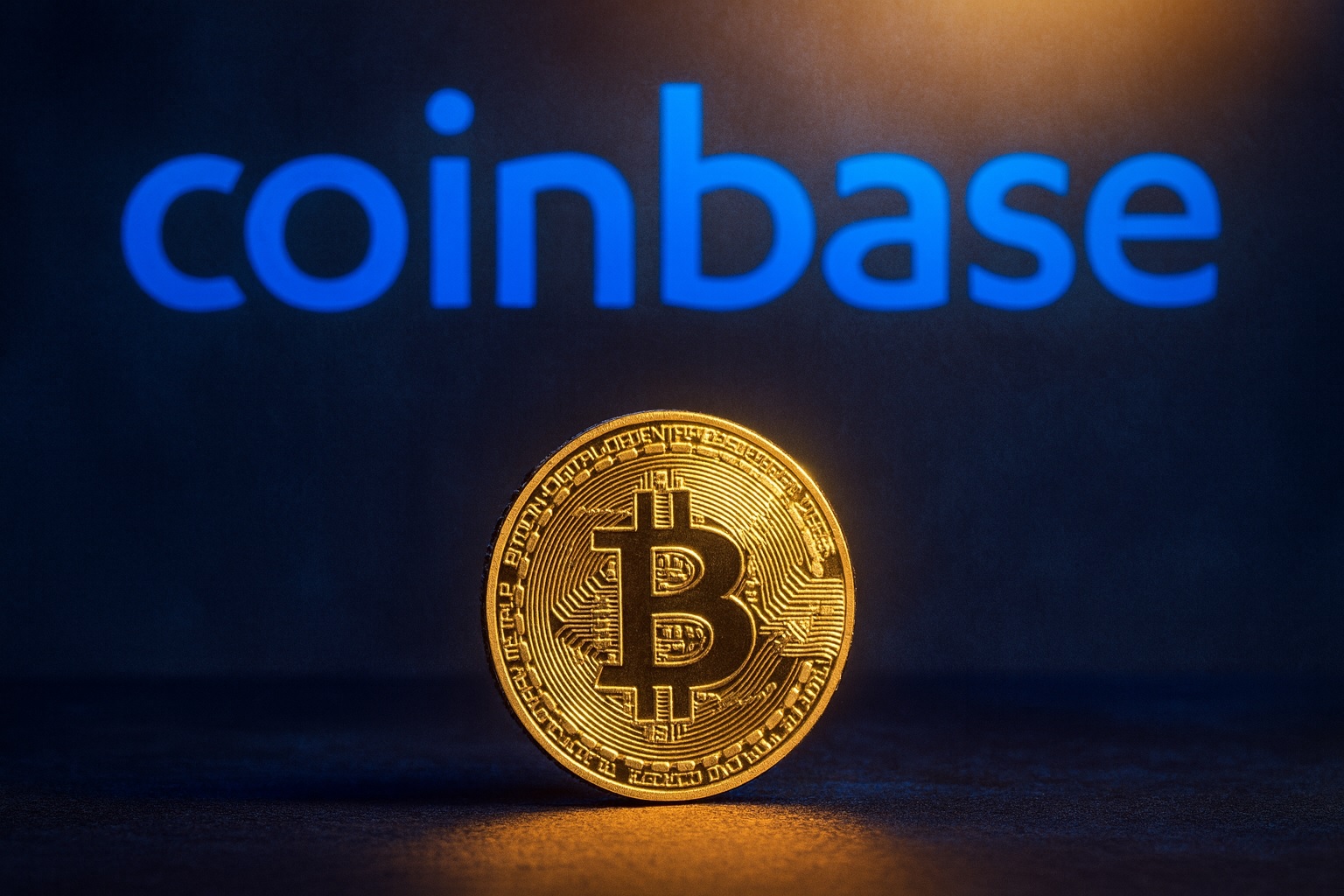- Surging Price, Recent Pullback: Coinbase Global (NASDAQ: COIN) stock trades around the mid-$330s per share after a volatile few weeks. It closed at $336.02 on Oct. 17 [1], roughly 10% below early-October highs (~$380) [2]. Shares slipped ~5.9% last week [3] but remain up over 40% year-to-date, outpacing the broader market and crypto industry (the crypto sector average is barely +0.4% YTD [4]). Coinbase’s market capitalization stands near $85 billion [5].
- Crypto Rally & ETF Catalyst: 2025’s crypto boom has been a major tailwind. Bitcoin hit a record ~$125,000 in early October [6] on optimism around U.S. policy and spot Bitcoin ETF launches, before pulling back to ~$107K mid-month amid market jitters [7]. Coinbase’s stock closely tracks crypto prices – despite efforts to diversify, COIN’s fate remains tightly correlated with Bitcoin’s ups and downs [8].
- Big Deals and Expansion: Coinbase is aggressively expanding its footprint. It held advanced talks to acquire UK-based stablecoin firm BVNK for $1.5–2.5 billion, reportedly edging out Mastercard in bidding [9] [10]. It also invested in India’s CoinDCX exchange at a $2.45 billion valuation [11] to tap growth in Asia. Earlier this year Coinbase acquired crypto derivatives exchange Deribit to offer futures and options [12], and struck a partnership with Samsung to give Galaxy users free access to Coinbase One services [13].
- Regulatory & Product Milestones: The company is seeking clearer oversight – in October it applied for a U.S. national trust bank charter with the OCC, aiming to expand payments services under federal supervision [14]. Coinbase also cheered recent regulatory moves: the SEC dropped its lawsuit against the company in early 2025 [15], and Congress passed new laws clarifying stablecoin and crypto staking rules (which Coinbase advocated) [16]. With regulatory clouds lifting and 8 of 11 spot Bitcoin ETF issuers using Coinbase as custodian, CEO Brian Armstrong calls Coinbase uniquely positioned as a compliant “crypto financial super-app.”
- Analyst Views – Bullish but Valuation High: Wall Street sentiment is broadly positive on COIN. Bernstein even calls Coinbase “the most misunderstood company” and hiked its price target to $510 – highest on the Street – citing Coinbase’s one-of-a-kind status (the only crypto-native firm in the S&P 500, key role in Bitcoin ETFs, growing stablecoin revenue, and its new Base blockchain network) [17]. Overall, 14 analysts rate it Buy (vs 10 Hold, 2 Sell) [18], with price targets ranging $185 to $510 and averaging about $380 [19]. However, some caution the stock looks expensive at 45–55× forward earnings, roughly 2× the industry P/E [20]. Coinbase’s rich valuation (Zacks Investment gives it a “Value” grade of F) means strong growth will be needed to justify further gains [21].
Stock Performance & Trends
Coinbase (COIN) stock price chart in October 2025. After soaring to multi-month highs on a crypto rally, COIN has cooled to the mid-$300s amid profit-taking and market volatility.
Coinbase’s stock has been on a rollercoaster in 2025. After starting the year around the low-$200s, COIN rocketed to an all-time high of $444.64 in mid-July [22] as enthusiasm for crypto peaked. A late-summer pullback saw shares dip under $313 in late September during a broader crypto sell-off [23]. Momentum turned again in early October: COIN surged over 20% in a week, hitting ~$380 by Oct. 3 [24] [25], fueled by Bitcoin’s own rally to record levels. That spike briefly put the stock near its 52-week high and far above its 52-week low of ~$143 [26].
Since then, Coinbase has cooled off alongside crypto. The stock gave back about 5–6% last week [27] and now hovers in the mid-$330s (as of Oct. 20). Technical indicators reflect this breather: the 14-day RSI has eased to ~47 (neutral) [28] after flashing overbought earlier in the month, and COIN remains above key moving averages (the 50-day near $324 and 200-day around $280) [29]. In short, the uptrend is intact but near-term momentum has moderated. Coinbase’s beta is ~3.7 [30], underscoring the stock’s outsized volatility – daily swings above 5% have not been uncommon this year.
Notably, Coinbase has dramatically outperformed traditional indexes in 2025. Even after recent dips, COIN is +40–45% year-to-date [31] (and roughly +71% from a year ago [32]), handily beating the S&P 500 (~12% YTD) and the broader fintech sector (~10% YTD) [33]. This highlights how investor appetite for crypto exposure has propelled Coinbase’s stock. By comparison, the average “crypto industry” stock is flat on the year [34], making Coinbase an outlier. Much of this strength is tied to the crypto market’s resurgence – when digital assets rally, Coinbase’s trading volumes and revenue tend to climb, boosting the stock. Indeed, Morningstar notes that despite Coinbase’s diversification efforts, its share price still “continues to track crypto prices” [35]. This was evident in October: Bitcoin’s climb to $125k sent COIN soaring, and Bitcoin’s subsequent 5% slide saw COIN retrench [36]. Investors essentially view Coinbase as a leveraged bet on the crypto market’s fortunes.
Another factor: earnings and guidance. Coinbase has gradually improved its financial results through 2023–2025 via cost cuts and new revenue streams. In Q2 2025, it eked out a small profit (EPS of $0.12) on $1.5 billion revenue [37] – a 40.9% net margin on an adjusted basis [38] – showing better efficiency even as retail trading activity normalized. The company’s gross margins are very high (~87%) and operating margin around 40% [39] thanks to lucrative trading fees and subscription services. Its balance sheet is strong (over $5B cash, current ratio ~2.1 and minimal debt at ~0.3× equity [40]), which provides stability amid crypto’s ups and downs. These fundamentals have given some investors confidence that Coinbase can weather volatility, though last quarter’s modest earnings miss showed it’s not immune to short-term swings [41].
Looking ahead, Q3 2025 earnings are due on Oct. 30 and will be a critical catalyst [42]. Analysts expect Coinbase to report a sequential revenue dip (reflecting lighter summer trading volumes) but improved subscription and services income [43]. Any surprise – positive or negative – could spark outsized stock moves given Coinbase’s high valuation. Management’s commentary on user growth, institutional trading, and new product traction will also be closely watched. For now, Coinbase’s stock is 20% off its peak but still up ~35–45% in 2025 [44] [45], a testament to the renewed crypto fervor that set in this year.
Latest News: Expansion, Deals & Partnerships
Coinbase’s recent rally has been underpinned not just by crypto prices but by major strategic moves. The company is actively expanding its reach through acquisitions, investments, and partnerships – positioning itself for the next leg of growth in the digital asset boom.
Stablecoin Power Play – $2.5B BVNK Deal: Perhaps the biggest headline was news that Coinbase and Mastercard are vying to acquire BVNK, a London-based fintech specializing in stablecoin payments. Multiple reports in early October revealed Coinbase is leading advanced talks to buy BVNK for $1.5–$2.5 billion [46] [47]. If it goes through, this would be the largest stablecoin acquisition ever and a bold bid to dominate crypto payment infrastructure. BVNK builds platforms for businesses to send/receive funds via stablecoins (digital tokens pegged to dollars) with instant settlement and low fees [48]. Controlling such “crypto rails” could significantly boost Coinbase’s presence in payments – a domain traditionally ruled by banks and card networks. Fortune’s sources say Coinbase currently has the inside track over Mastercard in the negotiations [49], though no final deal is signed and talks could still fall apart. Neither company has publicly commented, but industry analysts see this as a strategic tug-of-war: mainstream finance giants and crypto firms competing to shape the future of money movement [50]. Notably, just last year payment processor Stripe bought a similar startup for $1.1B [51], underscoring the fierce interest in stablecoin tech. If Coinbase clinches BVNK, it would deepen its diversification beyond trading, embedding it into the plumbing of global transactions – a potentially transformational move.
Betting on India – CoinDCX Investment: Coinbase is also expanding internationally. On Oct. 15, Coinbase announced an investment in India’s largest crypto exchange, CoinDCX, in a deal valuing CoinDCX at $2.45 billion [52]. Coinbase Ventures had been a prior investor since 2022, but this new funding round cements Coinbase’s commitment to the fast-growing Indian and South Asian crypto markets. “We believe India and its neighbors will help shape the future of the global on-chain economy,” said Coinbase’s Chief Business Officer Shan Aggarwal, highlighting the region’s importance [53]. CoinDCX reported ~$141 million annualized revenue as of mid-2025 [54] – a fraction of Coinbase’s size, but significant in a country where crypto adoption is rising despite regulatory uncertainty. By boosting its stake, Coinbase gains a stronger foothold to introduce its products in India (where it had a bumpy attempted launch in 2022) and possibly integrate CoinDCX’s user base with its own. This fits Coinbase’s broader strategy of “Go broad, then go deep” in international markets, identifying regional leaders to partner with or invest in. Along with India, Coinbase has been eyeing growth in Europe and recently the Middle East; for instance, it secured licenses in Spain, the Netherlands, and is reportedly exploring an expansion in the UAE. The CoinDCX deal – subject to regulatory approval – signals Coinbase’s determination to be a global crypto exchange, not just a U.S.-centric one, especially as emerging markets become crypto hotbeds.
Derivatives & Institutional Trading: Another significant milestone was Coinbase’s foray into crypto derivatives. Over the summer, Coinbase acquired Deribit, the world’s largest crypto options exchange, in a bid to offer a full suite of products [55]. Deribit boasted ~$185 billion in trading volume in a single month (July 2025) [56]. By bringing it in-house, Coinbase instantly gained a dominant position in Bitcoin and Ethereum options – a market previously out of reach due to U.S. regulatory constraints. The acquisition (reportedly around $500 million) is already adding revenue (≈$30M in July turnover from Deribit) and is expected to be accretive to Coinbase’s earnings [57]. Strategically, it means institutional traders can use Coinbase for everything: spot trading, futures, perpetual swaps, and options, all under one umbrella. This comprehensive offering is something even rival Binance doesn’t fully match, and it appeals to hedge funds and professional traders who value one-stop-shop liquidity. Coinbase’s institutional business has quietly become a cornerstone (the company custodying over $200B in assets and serving funds, corporations, and even pension managers). The Deribit move, along with launching an international futures exchange, shows Coinbase doubling down on the pro trading segment, which could drive more stable revenue than retail trading in the long run.
Consumer Growth and Partnerships: On the retail side, Coinbase is working to broaden crypto’s accessibility. A notable partnership came in early October with Samsung: new Samsung Galaxy smartphone users in the U.S. get free 3-month access to Coinbase One (Coinbase’s premium subscription) via the Samsung Wallet [58]. This gives users zero-fee trading, higher staking rewards, and other perks – effectively introducing millions of Samsung customers to Coinbase’s ecosystem. CEO Brian Armstrong hailed the deal, saying it brings crypto services to potentially “tens of millions” of new users and hinted at global expansions of this program [59]. It’s an example of Coinbase leveraging a mainstream brand to drive adoption beyond the typical crypto enthusiast. Coinbase has also been rolling out features like 24/7 phone support for Coinbase One members, more educational tools, and an improved user interface to make crypto trading friendlier. Additionally, the company has been listing new assets (including emerging altcoins and even supporting new stablecoins like WLFI’s USD1 token [60]) to ensure it remains the go-to platform for a broad array of digital assets. These efforts aim to keep retail engagement high, especially as competition for traders heats up (from apps like Robinhood and PayPal’s crypto services).
Payment Services & “Super App” Vision: A longer-term initiative is Coinbase’s push into payments and everyday finance. The company revealed it has applied for an OCC national trust charter – essentially a federal banking license – not to become a traditional bank, but to offer crypto-powered payment services under unified oversight [61]. Currently, Coinbase’s money services are regulated state-by-state (with a New York Trust charter via Coinbase Custody). A national charter would streamline launching products like Coinbase Pay, remittances, or even lending, by providing one set of federal standards. Coinbase’s execs stressed they “don’t seek to become a bank” but want the flexibility to integrate digital assets into traditional finance (for example, using stablecoins for e-commerce or payroll) without navigating 50 separate regulators [62]. If approved, this could pave the way for Coinbase to introduce a host of fintech offerings – think crypto debit cards (which it already has), direct deposit of paychecks into Coinbase accounts, bill pay in crypto, etc. Armstrong has spoken about Coinbase evolving into a “bank replacement” super-app [63], where users can invest, save, borrow, and pay all via crypto rails. Partnerships with the likes of Visa and Mastercard (Coinbase has existing collaborations on cards and is working with them on stablecoin standards) will be key to this vision. The BVNK acquisition mentioned earlier fits here, as it would give Coinbase proprietary stablecoin payment infrastructure to power such services. In essence, Coinbase is positioning to compete not just with crypto exchanges, but with PayPal, Cash App, and banks – bringing crypto into everyday finances.
Crypto Market & Regulatory Landscape
Coinbase’s prospects are inseparable from the broader cryptocurrency market and regulatory climate. After a brutal 2022 bear market, crypto roared back in 2023–2025, and Coinbase has ridden that wave. But investors are keenly aware that changing market trends or regulations can make or break the company’s fortunes.
Crypto “Spring” of 2025: This year has seen a dramatic crypto resurgence. Bitcoin, the bellwether, smashed through its old highs – reaching $125,000 in early October [64] – and is currently hovering around $110,000 [65] [66] (even after a mid-October dip). That’s roughly double its price at the start of 2025. Ethereum, too, traded near $4,000 recently [67], close to its all-time highs, with many smaller altcoins surging even more. This broad crypto rally (sometimes dubbed “Uptober” for Bitcoin’s typical October strength) has been a boon for Coinbase: higher crypto prices generally drive higher trading volumes and user activity on the platform, directly boosting Coinbase’s transaction fee revenue. For instance, during Bitcoin’s push past $100k in September, Coinbase saw a noticeable uptick in volumes and sign-ups (per the company’s own mid-quarter updates). Conversely, crypto volatility can cut both ways – a sudden 10% slide in Bitcoin can spook retail traders, temporarily hurting volumes, or lead to liquidations that dent market sentiment. So far, 2025’s volatility has been on the upside, which has clearly benefited Coinbase’s business and stock. The question is whether the crypto market can sustain these levels or if a correction looms as we head into year-end.
ETF Mania: A core driver of the 2025 crypto boom has been the advent of Bitcoin exchange-traded funds (ETFs) and other institutional products. After years of denial, the U.S. SEC in late 2024 and early 2025 finally approved multiple spot Bitcoin ETFs for trading [68], a watershed moment that brought a flood of institutional money into Bitcoin. Firms like BlackRock, Fidelity, and Invesco launched Bitcoin trusts that trade on exchanges, making it far easier for traditional investors to get Bitcoin exposure in retirement and brokerage accounts. Coinbase has been a big winner of this development – not only did the ETF news turbocharge crypto prices (and thus Coinbase’s stock), but Coinbase was chosen as the custodian and surveillance partner for 8 of the 11 ETF issuers [69]. In practice, that means Coinbase holds the actual Bitcoins underlying many of these funds and monitors trading for any manipulation, giving the SEC comfort. This role generates custody fees and cements Coinbase’s reputation as the trusted institutional gateway. “Coinbase is the backbone of the crypto ETF ecosystem,” one Bernstein analyst noted, highlighting that Coinbase now touches a large share of all Bitcoin invested through ETFs [70]. Furthermore, in September the SEC even approved options trading on BlackRock’s Bitcoin ETF (ticker IBIT) [71] [72], which expands the crypto derivatives market – another plus for Coinbase’s newly acquired Deribit unit. The ETF wave extends beyond Bitcoin: Ethereum futures ETFs launched, and a spot Ether ETF could be next, again areas where Coinbase could play a role (Coinbase Custody is expected to secure some Ether custodianships too). The bottom line is that Wall Street’s crypto embrace – via ETFs, hedge fund products, and even Bitcoin on corporate balance sheets – has moved crypto more mainstream, and Coinbase is a prime beneficiary of that institutionalization trend.
Regulatory Turning Point: Coinbase’s relationship with regulators has been a dramatic saga. In 2023–2024, the U.S. SEC had taken a hard line on crypto exchanges, suing Coinbase (and others like Binance) over allegations of unregistered securities offerings. This cast a long shadow over Coinbase’s stock, as investors feared a protracted legal battle or enforced changes to its lucrative trading model. However, in a surprise development, the SEC’s lawsuit against Coinbase was dismissed in February 2025 [73]. The regulator quietly dropped its case after court rulings in unrelated crypto lawsuits (e.g. Ripple’s partial win) suggested the SEC’s legal arguments might not hold up. This dismissal removed a huge legal overhang from Coinbase shares – one reason the stock is up so strongly this year. Coinbase’s Chief Legal Officer Paul Grewal noted at the time that Coinbase is committed to following the law and welcomed the chance to work constructively with regulators, rather than fight them in court [74].
Beyond that case, 2025 has seen significant progress in U.S. crypto regulation (likely helped by a more crypto-friendly administration). In mid-2025, Congress passed the “GENIUS Act” for stablecoin oversight and the “CLARITY Act” for crypto staking [75]. These laws set out formal rules for issuers of stablecoins (like requiring 1:1 reserves and audits) and allowed companies like Coinbase to offer staking/yield products under CFTC supervision. Coinbase strongly supported these measures – it has a stablecoin partnership (it co-founded USDC with Circle) and a growing staking business, so regulatory clarity here is bullish. “At last, a workable framework,” CEO Brian Armstrong tweeted, indicating such legislation would “unlock innovation while protecting consumers” (Coinbase had lobbied for clear rules instead of enforcement actions). The result: Coinbase can operate with more certainty that its key products won’t be suddenly outlawed. It’s worth noting the political backdrop too – several crypto-friendly bills are advancing, and Coinbase itself has been active in Washington (Armstrong made multiple trips to testify and even warned that innovation could leave the U.S. if regulators don’t adapt [76]). Now, with a mix of court wins and new laws, the U.S. crypto regulatory environment is thawing, which bodes well for Coinbase’s long-term prospects.
Abroad, regulators in Europe have also moved to establish clearer rules (the EU’s MiCA regulation will take effect in 2024, giving exchanges a passport to operate across member states). Coinbase has already obtained a license in Ireland to serve as its EU hub and is positioning to fully comply with MiCA. Similarly, in Asia, jurisdictions like Singapore and Japan have frameworks that Coinbase is navigating. In short, the regulatory winds have shifted from headwind to a more neutral or even tailwind position for Coinbase by late 2025. There are still challenges – e.g. the SEC has questioned Coinbase’s new blockchain “Base” over whether it could be seen as running an unregistered exchange [77], a point Coinbase disputes, and global anti-money-laundering rules are tightening. But compared to a year or two ago, Coinbase now operates with much more regulatory clarity and acceptance, which reduces risk for investors and encourages institutional participation.
Crypto Market Risks: Despite the optimism, Coinbase and its shareholders remain vigilant about potential market risks that could derail the current uptrend. Crypto markets are notoriously cyclical. The recent Coindesk analysis dubbed this October as possibly the “worst October in 10 years” for Bitcoin, down ~5% so far [78], bucking the usual “Uptober” trend. Macro-economic factors have crept in – for example, on Oct. 10, rumors of steep U.S.–China tariffs triggered a sharp sell-off in tech stocks and an 8% one-day plunge in Robinhood’s stock (and a dip in COIN as well) [79]. Geopolitical tensions, central bank policies (interest rate decisions), or a liquidity crunch could quickly cool the crypto market, which would hurt Coinbase’s trading volumes. Additionally, competition in crypto trading globally is fierce: while Binance has had regulatory troubles in the U.S., it’s still a dominant player overseas and recently relaunched in markets like South Korea [80]. New upstarts like decentralized exchanges (Uniswap, dYdX, etc.) also nibble at trading activity, especially among crypto-native users. Coinbase is responding by diversifying (as described, into derivatives, payments, international), but it must keep innovating to stay ahead.
There’s also the lingering question of crypto asset quality – e.g., if any major coin listed on Coinbase were revealed to be a fraud or collapse (as happened with Terra/Luna in 2022, though not on Coinbase), it could dent user trust. Coinbase has been more selective in listings lately to mitigate this risk. Lastly, security is paramount; a hack or loss of client funds would be devastating. Coinbase invests heavily in cybersecurity and has avoided any major hacks to date, but in crypto one can never be too careful. These are not immediate concerns given Coinbase’s track record, but they are factors that can impact the stock’s outlook. For now, the overall crypto landscape looks robust and growing, which forms a supportive backdrop for Coinbase as it heads into year-end – especially if a seasonal “crypto winter” can be averted this time around.
Analyst Commentary & Forecasts
Wall Street’s view on Coinbase has evolved in tandem with its fortunes. In 2022, sentiment was largely bearish amid the crypto downturn, but this year analysts have been racing to upgrade price targets and factor in Coinbase’s improving outlook. The current consensus per MarketBeat and FactSet is “Moderate Buy”, skewing bullish: roughly 14 Buy ratings, 10 Holds, and only 2 Sells [81]. The average 12-month price target is about $370–$380 per share [82], which is slightly above where the stock trades now, suggesting modest upside. However, there is an unusually wide dispersion in forecasts – reflecting the uncertainty (and volatility) inherent in Coinbase’s business.
On the bullish end, a number of analysts see significant upside if Coinbase continues to capitalize on the crypto boom. In early October, Bernstein’s analyst Gautam Chhugani made headlines by raising his target to $510 (from $310 prior) – the highest on the Street [83]. He argued that “Coinbase is the most misunderstood company” in the sector, pointing out that no other firm offers Coinbase’s combination of attributes [84]. As Bernstein’s note highlighted, Coinbase is the only crypto-focused name in the S&P 500, giving it a seal of legitimacy; it is integral to the coming ETF era (custodying bitcoins for the majority of U.S. ETF issuers); it has a 15% (and growing) revenue share from stablecoins and interest income [85] which many overlook; and it’s building valuable new platforms like the Base layer-2 network that could unlock future value. In Bernstein’s view, the market has not fully appreciated these strengths – hence calling Coinbase “misunderstood” and justifying a $500+ valuation. Other optimists include BTIG, which initiated coverage with a Buy and $410 target on Oct. 1 [86], citing Coinbase’s expanding product suite and improved cost discipline. Rothschild & Co (Redburn) likewise upgraded COIN to Buy with a $417 target [87], and Cantor Fitzgerald reportedly lifted its target into the $400s as well [88]. The bullish thesis generally assumes crypto adoption continues to rise, Coinbase maintains its market share, and new revenue streams (derivatives, subscriptions, institutional services) augment the volatile trading income.
Even some traditionally cautious firms have grown more positive: Goldman Sachs in October raised its target to $363 and reiterated a neutral stance, noting Coinbase’s execution has been strong but balancing that against high valuation [89]. J.P. Morgan (not cited above, but known to cover Coinbase) has highlighted Coinbase’s “operating leverage” – as volumes increase, profits can scale quickly – and improved regulatory outlook as reasons the stock could outperform if crypto markets remain healthy.
On the other hand, skeptics and bears haven’t disappeared. The recent rally itself has given a few analysts pause due to valuation. For example, Bank of America in early October trimmed its price target from $380 down to $340 [90], effectively calling the stock fully valued after the big run-up. BofA remains constructive on Coinbase’s business but is wary of the rich multiples. And indeed, by conventional metrics Coinbase looks pricey: at ~$330/share, it trades at about 45x forward earnings (and well over 20x EV/EBITDA) – far above the typical financial services stock. Zacks Investment Research recently flagged Coinbase’s stretched valuation, assigning it a Value grade of “F” and noting its forward P/E near 57 is roughly double the industry average (~24) and the S&P 500 (~23) [91]. Such metrics imply investors are paying a hefty premium for crypto growth. Bears also point out that Coinbase’s revenue is still largely transaction-based and if the crypto cycle turns downward, those revenues could dry up quickly (as happened in 2018 and again in 2022). H.C. Wainwright and Compass Point are two firms that have had Sell ratings on Coinbase in the past; in August, Compass Point actually downgraded COIN to Sell with a $248 target [92], arguing that competitive pressures and regulatory costs could weigh on future profits. While those targets look pessimistic now, they serve as a reminder that risks remain. Additionally, some analysts worry about share dilution – Coinbase has been generous with stock-based compensation, and its share count has steadily risen, which can cap per-share earnings growth.
Market technicians and short-term traders are also weighing in. Many note that COIN’s stock chart has formed higher highs and higher lows throughout 2025, a bullish pattern. As long as the stock stays above key support levels (e.g. ~$300, which is near the recent September low and a psychologically important round number), the uptrend is viewed as intact. Some see resistance around $380–$400; if COIN breaks above $400 again, it could retest the $444 record high. Options markets have been active on COIN, with relatively high implied volatility – meaning traders are paying up for protection or upside exposure, expecting big moves. Interestingly, short interest in Coinbase has declined in 2025; many short-sellers were squeezed out as the stock surged (short interest is around 6.5% of float now [93], down from double-digits early in the year). This reduction in bearish bets indicates growing investor confidence, though contrarians might say it removes a source of future buying (as fewer shorts left to cover).
All told, analysts foresee a wide range of outcomes. The most bullish see Coinbase evolving into a kind of “Goldman Sachs of crypto” – a dominant, regulated intermediary in a trillion-dollar asset class – and thus think today’s valuation will eventually look cheap if crypto continues to proliferate. The cautious camp sees Coinbase as a great company but possibly ahead of itself after a 250%+ rise from its 2022 lows, arguing that much of the near-term good news (like ETF approvals and legal victories) is already priced in. They recommend waiting for a better entry or for execution to catch up to the stock price. This divergence in views means Coinbase will likely remain a headline-making stock, prone to sharp moves on news or earnings. For investors, it underscores the importance of one’s outlook on crypto overall: as Morningstar’s analyst put it, “Even as Coinbase diversifies, [its] stock continues to track crypto prices” [94] – if you’re bullish on Bitcoin/Ethereum, you’re probably bullish on Coinbase, and vice versa.
Competitive Landscape & Industry Context
Coinbase operates at the intersection of the cryptocurrency industry and the traditional financial world. As such, its competition is multi-faceted: from pure crypto exchanges to fintech platforms to legacy institutions dipping into digital assets. Understanding Coinbase’s relative position helps in assessing its strengths and vulnerabilities.
Versus Other Crypto Exchanges: Coinbase’s most direct competitors are other crypto trading venues. Globally, the elephant in the room is Binance, which handles a huge portion of crypto trading volume. However, Binance is a private company and has been mired in regulatory issues in the U.S. and Europe (facing lawsuits and operational bans). This has somewhat played to Coinbase’s advantage – as a U.S.-regulated public company, Coinbase has been winning over users and institutional clients who seek a compliant platform. In regions like the U.S., Coinbase is clearly the dominant exchange after Binance.US’s market share dwindled. Kraken is another U.S.-based exchange that competes with Coinbase, particularly in the hardcore crypto trader segment, but Kraken is smaller and mostly privately held (though it’s reportedly eyeing an IPO of its own). Gemini, run by the Winklevoss twins, is yet another U.S. exchange competitor, but it too is much smaller in volume and has faced headwinds (including a high-profile dispute with DCG’s Genesis over yield products). In Europe and Asia, Coinbase is increasing its presence but faces local players (for example, Bitstamp in Europe or Upbit in Korea). Coinbase’s key differentiator in this pack is trust and breadth: it’s known for strong security (never hacked), follows KYC/AML rules, and has a broad listing of reputable assets (while generally avoiding the sketchier tokens). This has made it the go-to choice for many institutional investors and retail users who prioritize safety over the absolute lowest fees. It’s telling that during 2023–2025’s regulatory crackdowns, Coinbase saw net inflows of assets while some rivals saw outflows – users moved funds to Coinbase for perceived safety.
Versus Fintech Brokers (Robinhood, etc.): Another set of competitors are fintech trading apps that offer crypto alongside stocks. The prime example is Robinhood Markets (HOOD), which has aggressively expanded into crypto trading since 2018. In fact, Robinhood’s 2025 performance has been astonishing – its stock is up ~250% this year and hit all-time highs (~$153) after being added to the S&P 500 [95] [96]. Robinhood now boasts a $120+ billion market cap, even larger than Coinbase’s [97]. The company rode a boom in stock trading and options, but crypto is a significant part of its business (Robinhood offers commission-free trading in major coins and held over $11B in crypto assets for users). Robinhood’s massive rally was driven by surging profits and new product launches – including innovative crypto offerings like 24/7 trading of tokenized stocks in Europe and micro crypto futures [98]. This shows the lines are blurring: Robinhood is becoming more crypto-like (offering tokenized assets) while Coinbase is becoming more fintech-like (offering banking features). However, there are differences. Robinhood’s revenue model for crypto is different (they rely on spreads rather than explicit fees, and they don’t have the same depth of crypto services like Coinbase’s staking or wallet offerings). Also, Robinhood’s user base skews more towards equities traders dabbling in crypto, whereas Coinbase’s are crypto-native users. In any case, the two are increasingly in competition for retail trading activity. Robinhood’s success (and rich valuation at ~60x earnings) [99] also signals that the market sees enormous growth potential in app-based trading platforms. Coinbase will want to capture some of what Robinhood has – possibly by offering equities trading itself via tokenization or partnerships (there have been rumors of Coinbase exploring tokenized stock trading for U.S. users eventually). On the flip side, Robinhood has signaled interest in more crypto features, but it’s constrained by its U.S. broker-dealer structure for now. Both companies aspire to be “the finance super-app” for millennials and Gen Z, so their competition could heat up in coming years.
Versus Traditional Finance: Interestingly, Coinbase is also competing/cooperating with traditional financial giants. For instance, Nasdaq, NYSE (ICE), and CME have all made moves in crypto. Nasdaq was working on a crypto custody solution (though it paused those plans in late 2023), and ICE (owner of NYSE) had launched Bakkt (a crypto trading platform) – though that didn’t gain huge traction. The CME offers Bitcoin and Ether futures, which indirectly competes with Coinbase’s own derivatives business internationally. So far, traditional exchanges haven’t taken a big chunk of the spot crypto market, but their presence looms. Investment banks like Goldman Sachs and Morgan Stanley have also dabbled by offering Bitcoin funds to clients, etc., but again, they often partner with firms like Coinbase to execute trades. Interactive Brokers (IBKR) and Charles Schwab (SCHW) have started allowing crypto trading on their platforms in limited ways, usually routing orders to Paxos or Coinbase. PayPal launched its own stablecoin (PYUSD) and offers crypto buying to its 400 million users, theoretically a competitive service to Coinbase for casual users. Yet, none of these players currently threaten Coinbase’s core exchange volume – rather, many partner with Coinbase. For example, PayPal’s crypto buy/sell is powered by Paxos, but Coinbase competes by marketing itself as more feature-rich. And notably, Coinbase has inked partnerships with JPMorgan and PNC Bank in recent years for crypto custody and payments [100], showing a collaborative approach with banks. In fact, the reason Coinbase seeks an OCC charter is partly to integrate with the banking system more seamlessly (for payments, etc.), effectively bringing crypto to traditional finance rather than waiting for banks to invade crypto.
One could argue Coinbase’s true competitive moat is its trusted brand and regulatory compliance, which are hard for a startup to replicate quickly, and which some big traditional firms lack when it comes to crypto expertise. It’s telling that when BlackRock wanted to launch a Bitcoin ETF, it didn’t try to custody Bitcoin itself – it went to Coinbase. That speaks to Coinbase’s reputation. Going forward, competition may intensify: if crypto prices remain high, expect more fintechs and banks to expand crypto offerings. Coinbase will need to leverage its first-mover advantages, continue innovation (like its new Base blockchain, which could eventually host DeFi apps that tie into Coinbase), and perhaps adjust pricing to stay competitive (its trading fees are higher than some rivals, though many users are willing to pay for the trusted platform).
Market Share and Growth: In terms of market share, Coinbase has roughly 10% of global centralized exchange (CEX) trading volume in crypto (it fluctuates; during U.S. trading hours it’s higher, overnight lower). This is sizable for a single exchange given how fragmented the crypto market is across dozens of venues. In the U.S., Coinbase’s market share is estimated around 50% or more of fiat-to-crypto volume. The company reports having over 110 million verified users (though monthly transacting users are around 7–8 million as of Q2 2025) [101]. User growth had slowed in the bear market but picked up again in 2023/24; interestingly, Coinbase’s user base might be smaller than Robinhood’s 14 million active users, but Coinbase users on average have higher balances in crypto. If crypto adoption continues (with potentially billions of users in the future owning digital assets), Coinbase is strategically placed to capture a meaningful chunk, but it must keep evolving to serve what those future users need – which could be things like instant payments, DeFi access, digital ID services, etc., not just trading. Coinbase’s strategy of becoming an “all-in-one” platform, plus its moves into international markets and new verticals, suggest it’s aiming to entrench itself deeply before competition catches up.
One should also note indirect competition: MicroStrategy (MSTR), for instance, isn’t an exchange but some investors play it as a Bitcoin proxy (since MSTR holds ~640k BTC on its balance sheet). In 2025, MicroStrategy’s stock performance has mirrored Bitcoin’s, at times even outperforming COIN stock in short spurts. However, Coinbase offers a more diversified exposure (not just to Bitcoin’s price but to crypto trading activity and the ecosystem growth). Similarly, crypto mining companies (like Marathon Digital or Riot Platforms) are another way investors play the crypto sector – those stocks exploded higher in early 2025 with Bitcoin’s rally, sometimes surpassing Coinbase in percentage gains. But they carry different risks (commodity-like exposure to mining costs). The point is, investor money flows into various crypto plays, and Coinbase competes in that sense for capital with all these. Coinbase’s inclusion in the S&P 500 (since 2023) has helped it in this competition, as index funds now hold COIN, and many generalist investors view it as the blue-chip crypto stock.
In summary, Coinbase stands at a unique crossroads. It’s competing with nimble crypto startups on one side and giant financial institutions on the other. So far, it has managed to carve out a leadership position by bridging the two worlds – being crypto-forward enough to attract true crypto users, yet regulated and integrated enough to appeal to banks and ETFs. Its main competitors each attack a piece of its business (trading fees, new products, regions), but Coinbase’s comprehensive approach and trust factor give it a strong defensive edge. The industry context in 2025 is far more favorable than a few years ago: crypto is mainstreaming, and instead of shunning it, big players are partnering with specialists like Coinbase. As crypto grows, there may be room for multiple winners, but Coinbase is clearly intent on being the market leader in the Western world. Its ability to continue executing on innovation and maintain user trust will determine if it can fend off rivals and justify the market’s optimistic bets.
Conclusion: High Stakes for a Crypto Heavyweight
Coinbase Global has had a breakout year in 2025, reasserting itself as the premier public crypto company at a time when digital assets are reaching new heights. The stock’s strong gains reflect a confluence of positive factors – booming crypto prices, institutional acceptance (via ETFs), major expansion moves, and improved regulatory clarity – all playing to Coinbase’s strengths. Yet, at its core, Coinbase remains a bet on the crypto economy itself. If Bitcoin and its peers continue to thrive, and if blockchain technology keeps gaining adoption, Coinbase is likely to ride that wave and could see further upside. The company’s push to diversify revenue (with subscription services, derivatives, and broader financial offerings) is aimed at making it less cyclical and more of a long-term fintech player, which could in time earn it a higher valuation multiple like other fintech growth stocks.
However, investors should keep in mind that volatility is the norm, not the exception, for Coinbase. Just as quickly as sentiment improved, it could sour if, say, a crypto market correction hits or if Coinbase stumbles in a new initiative. The stock’s current valuation already prices in quite a bit of success. That leaves little room for error – the upcoming earnings and execution on initiatives like the BVNK acquisition or the Base network will need to validate the bullish thesis. In the near term, trading momentum and headlines will likely drive COIN: a surprise SEC decision, a sudden Bitcoin price move, or macro news can all cause outsized swings in either direction.
For now, though, Coinbase finds itself in an enviable spot: strong momentum, expanding opportunities, and recognition from Wall Street that it’s more than just a flash-in-the-pan. “Coinbase has proven able to pivot and thrive, even in a rapidly changing crypto landscape,” as one analyst put it recently. The company’s ability to combine Silicon Valley innovation with Wall Street rigor might well determine its trajectory from here. If the crypto revolution continues its march into mainstream finance, Coinbase’s growth story could just be getting started. As 2025 heads into the final stretch, all eyes will be on whether Coinbase can sustain its rally – perhaps even making a run toward those loftier analyst targets – or whether the inherent twists and turns of crypto markets will prompt a detour. In either case, Coinbase has firmly re-established itself as a bellwether of the crypto sector, and its journey will be closely watched by traders and true believers alike.
Sources: Coinbase & ts² TechStock analysis [102] [103]; Reuters [104] [105]; CoinDesk [106]; Morningstar [107]; Yahoo Finance/CoinRepublic [108] [109]; Finviz [110] [111]; TechCrunch [112]; Bloomberg; Company filings.
References
1. www.stocktitan.net, 2. ts2.tech, 3. finviz.com, 4. www.thecoinrepublic.com, 5. www.stocktitan.net, 6. www.reuters.com, 7. www.coindesk.com, 8. milled.com, 9. www.coindesk.com, 10. www.coindesk.com, 11. www.reuters.com, 12. www.stocktitan.net, 13. ts2.tech, 14. ts2.tech, 15. ts2.tech, 16. ts2.tech, 17. ts2.tech, 18. ts2.tech, 19. finviz.com, 20. www.thecoinrepublic.com, 21. www.thecoinrepublic.com, 22. www.thecoinrepublic.com, 23. ts2.tech, 24. ts2.tech, 25. ts2.tech, 26. www.thecoinrepublic.com, 27. finviz.com, 28. finviz.com, 29. ts2.tech, 30. finviz.com, 31. www.thecoinrepublic.com, 32. finviz.com, 33. www.thecoinrepublic.com, 34. www.thecoinrepublic.com, 35. milled.com, 36. www.coindesk.com, 37. ts2.tech, 38. ts2.tech, 39. finviz.com, 40. finviz.com, 41. ts2.tech, 42. www.thecoinrepublic.com, 43. ts2.tech, 44. www.thecoinrepublic.com, 45. finviz.com, 46. www.coindesk.com, 47. www.coindesk.com, 48. www.coindesk.com, 49. www.coindesk.com, 50. www.coindesk.com, 51. www.coindesk.com, 52. www.reuters.com, 53. www.reuters.com, 54. www.reuters.com, 55. www.stocktitan.net, 56. www.stocktitan.net, 57. www.stocktitan.net, 58. ts2.tech, 59. ts2.tech, 60. www.stocktitan.net, 61. ts2.tech, 62. ts2.tech, 63. ts2.tech, 64. www.reuters.com, 65. www.coindesk.com, 66. www.coindesk.com, 67. www.coindesk.com, 68. www.congress.gov, 69. ts2.tech, 70. ts2.tech, 71. www.reuters.com, 72. www.reuters.com, 73. ts2.tech, 74. ts2.tech, 75. ts2.tech, 76. ts2.tech, 77. ts2.tech, 78. www.coindesk.com, 79. ts2.tech, 80. finviz.com, 81. ts2.tech, 82. finviz.com, 83. finviz.com, 84. ts2.tech, 85. ts2.tech, 86. ts2.tech, 87. ts2.tech, 88. ts2.tech, 89. ts2.tech, 90. ts2.tech, 91. www.thecoinrepublic.com, 92. finviz.com, 93. finviz.com, 94. milled.com, 95. ts2.tech, 96. ts2.tech, 97. ts2.tech, 98. ts2.tech, 99. ts2.tech, 100. ts2.tech, 101. ts2.tech, 102. ts2.tech, 103. ts2.tech, 104. www.reuters.com, 105. www.reuters.com, 106. www.coindesk.com, 107. milled.com, 108. www.thecoinrepublic.com, 109. www.thecoinrepublic.com, 110. finviz.com, 111. finviz.com, 112. techcrunch.com







